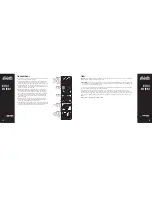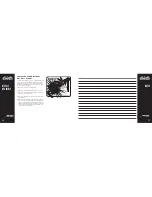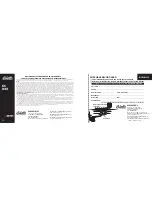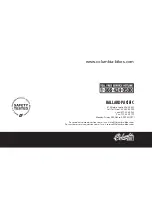
42
43
BICYCLE
ASSEMBLY
BICYCLE
ASSEMBLY
FRONT SHIFTER
Note that not all models have a front shifter. The front (left) shifter will
have an indicator that reads either “low to “high” or a series of numbers
from 1 up. Low or “1” is the lowest gear.
The front shifter acts much like the rear shifter, but the change between
gears is greater. This means that one shift at the rear derailleur will be
a subtle change in pedaling speed, but one shift at the front derailleur
will be a large change in pedaling speed. Think of the front shifter as a
“range”, low and high or low, medium, and high. Low is used for slower
riding, hill climbing, or to allow for easier pedaling. It is recommended to
start off in this gear and move through the gears as speed increases as
needed, or comfortable. It is OK to ride the whole time in only one gear
if this is comfortable. Shift only while pedaling forward. When shifting,
lessen the pressure exerted on the pedals during the shift. Once you
have successfully shifted gears, it is OK to start to pedal hard if desired.
Pedaling hard while shifting can cause the chain to skip and not engage
the appropriate gear. Backpedaling should be avoided on derailleur
bikes because the chain can jam and cause the bike to become unstable.
EXTERNAL GEARS (Derailleur equipped bicycles)
Derailleur equipped bicycles all have a rear derailleur. Some may also
have a front derailleur offering more gear choices. The right side
shifter will operate the rear derailleur, and the left side (if equipped)
will operate the front derailleur. On derailleur equipped bicycles, it is
important to be pedaling forward when shifting gears. This allows the
chain to “derail” from one gear to the next. Operating the shifter while
sitting still or not pedaling can cause damage to the system, and can
be dangerous, as the chain may jam and cause the bike to become
unstable.
(Fig. A)
Avoid back pedaling on any bicycle with derailleurs. Backpedaling can
derail the chain and cause it to jam or fall off the gears. When shifting
gears, make sure you pedal forward until the gear has completely
changed. (At least one full rotation of the pedals.) Failure to do so,
may result in the chain not engaging properly the next time you pedal
forward, or falling off altogether causing a possible danger when you
attempt to pedal again. Remember always pedal through the gear
change on a derailleur equipped bicycle.
REAR SHIFTER
The rear shifter (right) will have an indicator that reads either “low
to “high” or a series of numbers from 1 up. Low or “1” is the lowest
gear. This is used for slower riding, hill climbing, or to allow for easier
pedaling. It is recommended to start off in this gear and move through
the gears as speed increases as needed, or comfortable. It is OK to ride
the whole time in only one gear if this is comfortable. Shift only while
pedaling forward and seated. When shifting, lessen the pressure exerted
on the pedals during the shift. Once you have successfully shifted gears,
it is OK to start to pedal hard if desired. Pedaling hard while shifting
can cause the chain to skip and not engage the appropriate gear.
Backpedaling should be avoided on derailleur bikes because the chain
can jam and cause the bike to become unstable. See Assembly and
Maintenance for further information on proper gear adjustment.
(Fig. B)
Freewheel
cogs
Front
derailleur
Rear
derailleur
Guide
pulley
Front
chainwheels
Crank arm
Pedal
Derailleur
control cable
FIG. A
FIG. B























